In this article, we will explore the top 30 iron rich foods for vegans and vegetarians . We will also discuss how much Iron you need per day as a vegan, how to increase iron absorption from plant-based foods and what is Iron Deficiency Anemia, causes and symptoms. Stay tuned.
But What Is Iron Anyway?
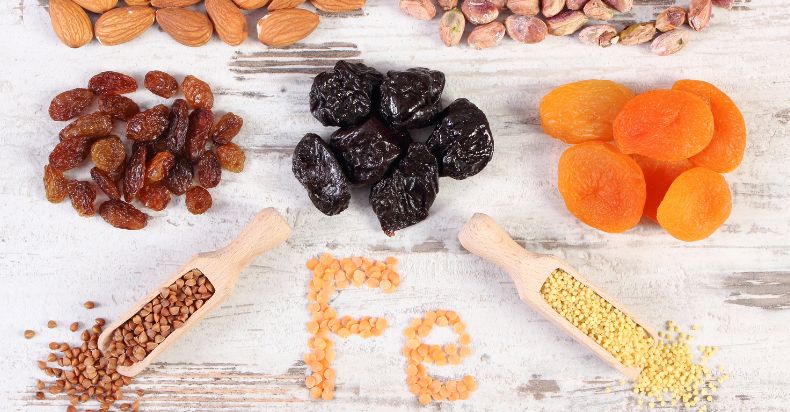
Iron (Fe) is an essential mineral found in every cell of the body and participates in a wide variety of metabolic processes. It is primarily involved in the transfer of oxygen from the lungs to tissues by red blood cell hemoglobin.
About 70% of Iron in the body is found in myoglobin (muscle cells) and hemoglobin. In addition, about 25% of the iron in the body is stored as ferritin, circulates in the blood and is found in cells.[1]
The immune system is also dependent on iron for its normal functioning, plus, it is involved in the production of enzymes and the conversion of blood sugar to energy.
Lot of vegetables, legumes, and other foods contain a form of iron called nonheme iron, and the other type of iron found in animal products is called heme iron.
The following are best iron rich foods for vegetarians and vegans:
1- Dried seaweed (spirulina) – 28,5 mg of Fe/100g
Also called ancient super food, seaweed has been a part of the Japanese diet for centuries due to its wide array of minerals and vitamins.
It’s one of the best iron rich foods for vegans and vegetarians as it is the most vegan foods that have more iron.
2- Chia seeds – 16,4 mg of Fe/100g
Chia seeds are among the most nutritious foods on the planet. Moreover, they are non-GMO and gluten free.
The Chia Seeds are considered a good vegetarian sources of iron.
3- Morel mushrooms (raw) – 12,2 mg of Fe/100g
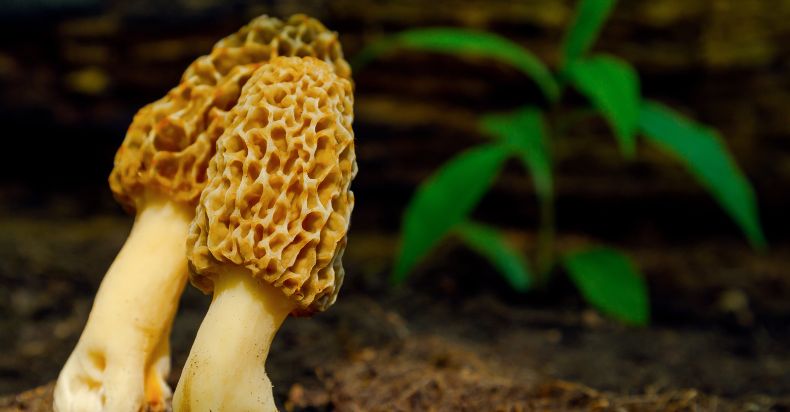
These tasty fungi provide considerable stores of nutrients, making them a healthy addition to any meal.
In addition, morel mushrooms are a great source of ergocalciferol (vitamin D2).
4- Lemongrass (raw) – 8,2 mg of Fe/100g
Lemongrass, also called fever grass, is a good source of vitamins A and C, B9, magnesium, phosphorus, copper, zinc, potassium, manganese and calcium.
5- Cashews (raw) – 6,7 mg of Fe/100g
Cashews are versatile nuts that fight heart disease and prevents type 2 diabetes Mellitus, gallstones, and cancer.
Cashews is one of the highest vegan iron sources.
6- Sesame seeds (hulled, dried) – 6,4 mg of Fe/100g
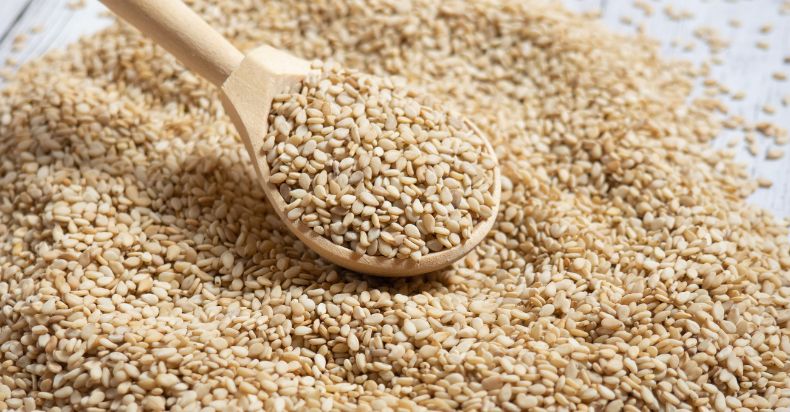
Not only are these seeds an excellent source of manganese and a very good source of copper, but they are also a good source of magnesium, calcium, phosphorus, vitamin B1, molybdenum, zinc, selenium, and fiber.
Sesame seeds are one of the best iron rich foods for vegans and vegetarians.
READ : 5 Known Types of Vegetarian
7- Parsley (raw) – 6,2 mg of Fe/100g
Parsley can be found throughout the year on the market and acts as a pain reliever with anti-inflammatory functions.
Parsley raw is one of the best vegan foods high in iron.
8- Oat bran (dry) – 5,4 mg of Fe/100g
Oat bran contains about 50 percent more fiber than oatmeal, making it more effective at helping digestion and lowering LDL (bad) cholesterol.
Furthermore, it has more calcium, protein, phosphorus, thiamin, magnesium, riboflavin, and zinc.
9- Spinach (boiled) – 3,9 mg of Iron/100g

Many studies have concluded that spinach helps maintain your vigorous brain function, mental clarity, and memory due to its content of an antioxidant known as alpha-lipoic acid.
10- Almonds (raw) – 3,7 mg of Fe/100g
Besides being a good source of iron, Almonds are also a good source of molybdenum, magnesium, riboflavin, and phosphorus.
11- Jerusalem artichokes (raw) – 3,4 mg of Fe/100g
Better known as sunchokes, they provide a number of minerals and vitamins with many health benefits because of their role as a prebiotic.
12- Blackstrap molasses – 3,4 mg of Fe/100g
Blackstrap molasses is a nutrient-dense byproduct of the white sugar refining process that contains copper, magnesium, and other nutrients.
13- Lentils (cooked) – 3,3 mg of Fe/100g
Lentils are easy to prepare with numerous health benefits like the ability to maintain and improve heart health, fight blood sugar fluctuations that can lead to diabetes, or help you to lose weight in a natural way.
14- Chickpeas (cooked) – 2,9 mg of Iron/100g
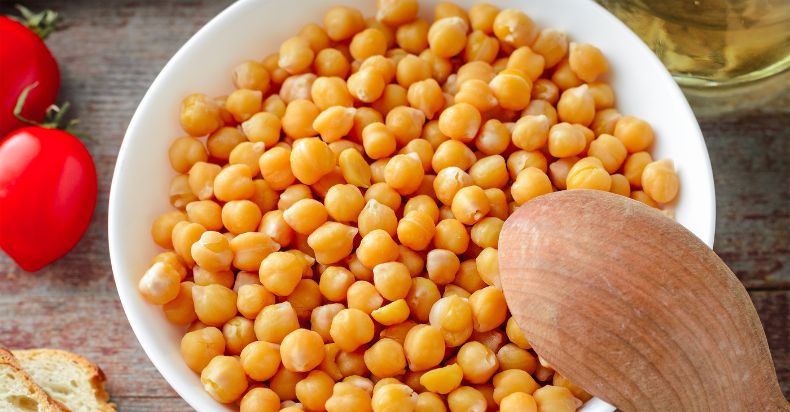
Chickpeas, also known as garbanzo beans, are an important ingredient in many Indian and Middle Eastern dishes such as falafels, hummus, and curries.
They contain many phytochemicals, antioxidants, and phytate and are rich in both insoluble and soluble dietary fiber.
This is one of the high iron vegan meals.
15- Red kidney beans (cooked) – 2,9 mg of Fe/100g
Packed with essential amino acids, vitamin B9, fiber, potassium, magnesium, and a number of other important health-promoting nutrients, these legumes are a true superfood.
In addition, they are loaded with manganese that acts as an antioxidant defense.
16- Lima beans (cooked) – 2,4 mg of Fe/100g
Lima beans are also an excellent source of copper, dietary fiber, molybdenum, and manganese.
17- Brazil nuts – 2,4 mg of Fe/100g
Brazil nuts contain minerals such as manganese, potassium, selenium, phosphorus, calcium, and zinc.
18- Raisins (uncooked) – 1,9 mg of Fe/100g
The health benefits of raisins include relief from acidosis, constipation, fever, anemia, and sexual dysfunction.
Raisins are good sources of iron for vegans.
19- Swiss chard (raw) – 1,8 mg of Fe/100g
Swiss chard, a member of the chenopod plant family, is a leafy green vegetable with an extremely high nutrient-density.
The first documented use of swiss chard in cooking was in Sicily. Furthermore, this vegetable is now even being grown in space.
20- Kale (raw) – 1,5 mg of Fe/100g
Kale, like other dark green veggies, may be helpful in preventing different cancers such as prostate, colon, and ovarian.
21- Quinoa (cooked) – 1,5 mg of Fe/100g
The health benefits of quinoa include reducing the risk of type 2 diabetes Mellitus, cardiovascular disease, colon cancer, or hypertension.
22- Brussels sprouts (cooked) – 1,2 mg of Fe/100g
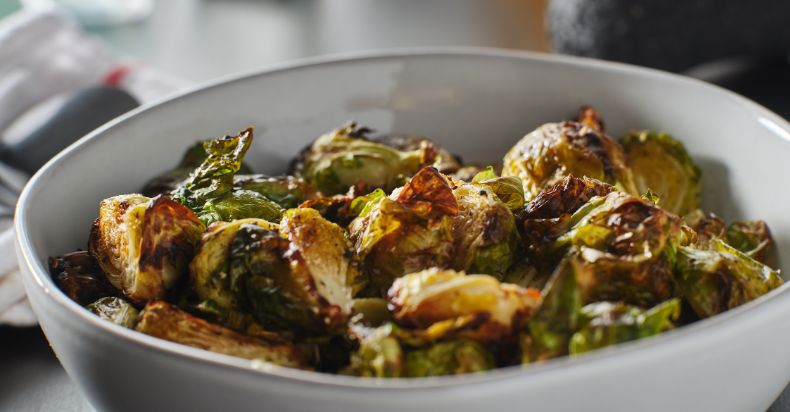
Brussels sprouts are a very good source of vitamin B9, vitamin B6, manganese, choline, dietary fiber, vitamin B1, copper, phosphorus, potassium, and omega-3 fatty acids.
23- Turnip greens (raw) – 1,1 mg of Fe/100g
They are also an important source of beta-carotene, vitamin K, and vitamin C.
24- Prunes – 0,9 mg of Fe/100g
Dried plums, also known as prunes, are a rich source of vitamins and minerals.
25- Broccoli (raw) – 0,7 mg of Fe/100g
Broccoli belongs to the cruciferous vegetable family, that includes cauliflower, kale, bok choy, Brussels sprouts, cabbage, and rutabaga.
26- Brown rice (steamed) – 0,6 mg of Fe/100g
Health benefits of brown rice include better functioning of the digestive system, cardiovascular system, and nervous system.
27- Millet (cooked) – 0,6 mg of Fe/100g
Millet is so important because of its uniquely high content of minerals and vitamins, including impressive starch levels.
28- Oriental radishes (raw) – 0,4 mg of Fe/100g
Daikon, also known as the Chinese radish or Oriental radish, is one of many cruciferous vegetables associated in studies with successful cancer prevention.
29- Potatoes (boiled) – 0,3 mg of Fe/100g
Potato is usually underrated in regards to its nutritional benefits.
Nevertheless, it is packed with a variety of minerals, vitamins, and phytochemicals that benefit human health.
READ : Are Potato Wedges Vegan?
30- Tomatoes (raw) – 0,3 mg of Fe/100g
Tomatoes can be prepared in a seemingly endless number of dishes, as well as being great to eat alone.
They can reduce heart disease and potentially prevent numerous chronic diseases if consumed daily.
These was the iron rich foods for vegetarians and vegans.
How Much Iron Do You Need Per Day?
Recommended Dietary Allowance (RDA) for Iron
| Age/Group | Life Stage | Iron (mg/day) |
| Infants | 0–6 months | 0.27 |
| 7–12 months | 11 | |
| Children | 1–3 years | 7 |
| 4–8 years | 10 | |
| Males | 9–13 years | 8 |
| 14–18 years | 11 | |
| > 18 years | 8 | |
| Females | 9–13 years | 8 |
| 14–18 years | 15 | |
| 19–50 years | 18 | |
| > 50 years | 8 | |
| Pregnant Women | – | 27 |
| Lactating Women | 14–18 years | 10 |
| 19–50 years | 9 |
How to increase iron absorption from plant-based foods?
How do vegans increase iron levels?
Eat foods rich in vitamin C and other organic acids (such as strawberries, citrus, tomatoes, bananas, and potatoes);
Avoid calcium found in fortified foods and dairy products;
Drinking coffee or tea with meals can reduce the absorption of Iron by 50-60 percent.
What is Iron Deficiency Anemia?
This condition is often disregarded by many.
People who were diagnosed with iron deficiency anemia and anemia, most especially in the developed countries, tend to ignore it and give it much less attention compared to other sickness.
But beware, because a recent study shows that this ailment has the biggest effect on the socio-economic growth of a nation.
People who have iron deficiency anemia tend to become less productive because they cannot think very well and their physical strength is also low.
Iron Deficiency Anemia (IDU) is different from Anemia. There are a lot of reasons why a person become anemic.
Women are more prone to such condition because of their blood loss during their menstrual cycle.
Pregnancy can also be a reason of lack of iron in the body, primarily because mothers tend to share their iron with the babies inside their womb.
Although most of the time it is because of our negligence and non-healthy lifestyle that lead us to be anemic, there is some situation that an individual is inflicted with a rare case of Celiac Disease.
This is a condition wherein the body is not capable of absorbing the iron.
People must be more observant and mindful of the small things that are happening on their body.
Iron Deficiency Anemia or IDU has the common symptoms like any other simple ailments.
People must be watchful on the following occurrences: anxiety, irritability, constipation, sleepiness, palpitation, hair loss, depression, twitching muscle, tingling, numbness, burning sensation, poor appetite, missed menstrual cycle, and heavy menstrual period for women.
Treatment of Iron Deficiency Anemia is pretty much simple than what we think.
Mainly people who suffer from this disorder only have to learn how to eat and maintain a balance diet.
Add more green leafy vegetable, lean red meats, and beans on your daily food intake.
Iron Deficient patients are recommended by medical practitioners to regularly take supplement or vitamins for extra absorption of iron.
Remember that living a clean and healthy lifestyle is the best preventive measure to all diseases.
READ : The 10 Commandments of Staying Vegan
Iron Deficiency Anemia Symptoms and Causes
Iron is an essential component for the formation of hemoglobin, which is responsible for the development of red blood cells in the body.
The red cells in the blood are the carrier of oxygen in the body and the ones responsible for the distribution.
Iron is a vital element for the formation of hemoglobin. It can be found in different food sources. Imbalance nutrition and other underlying medical conditions might lead to IDA.
Iron deficiency anemia symptoms and causes are common these days, because of the unhealthy eating habits and lifestyle of many people.
There are many people that are affected with iron deficiency anemia, which is the most common form of anemia.
In the statistics, twenty percent of women have IDA, three percent of men, and fifty percent of pregnant women since they are nourishing the fetus inside them.
The common iron deficiency anemia symptoms and causes are due to the diet, and when there is a significant loss of blood.
Other relative causes are poor iron absorption by the body, growth spurt and pregnancy.
When the normal level of iron in the body becomes scarce or depleted, it will be the time that anemia will take its toll by affecting the health of a person.
The lack of iron plays significant changes in the normal functioning of the body.
The red blood cells cannot carry enough oxygen for the body, because when there is limited a limited supply of iron, the formation of hemoglobin will be hindered.
A person can easily get weak when anemic due to oxygen starvation because of lack of iron.
Iron deficiency anemia symptoms and causes are also because iron is a vital component of myoglobin, which enables the muscles in the body to store oxygen.
The body cannot achieve its optimum physical function when there is a deficiency.
The common people who are high risk for developing iron deficiency anemia are women, because they usually eliminate blood during menstruation.
Those who are suffering from peptic ulcer disease, colon cancer and using aspirin for a long time are also at risk.
Knowing the basic iron deficiency anemia symptoms and causes will help people in becoming aware of what they should eat, and what will be the effects if they have abnormal low iron levels in the blood.
The common indications of being anemic are fatigue, dizziness, paleness, irritability, weakness, difficulty in breathing or shortness of breath, poor appetite, brittle nails, and sore tongue.
It is also common in children and early adolescent undergoing rapid growth.
Causes include:
- Inadequate dietary Fe;
- Stomach ulcer;
- Impaired Fe absorption;
- Frequent blood donations;
- Stomach cancer;
- Chronic kidney disease;
- Loss of body Fe in the urine;
- Bleeding.
Symptoms include:
- Shortness of breath;
- Lack of energy;
- An altered sense of taste;
- Irritability;
- A pale complexion;
- Dizziness;
- Reduced resistance to infection;
- Low birth weight babies and premature births;
- Headaches;
- Poor scholastic performance;
- Hair loss;
- Unexplained weight loss.
Note – pregnant women with severe anemia have a higher risk of complications after birth.
Iron Deficiency Anemia Natural Remedies
Anemia occurs when levels of hemoglobin in the blood are lower than normal.
This medical condition often causes body weakness, paleness, shortness of breath, fast heart rate as well as low blood pressure.
Anemia becomes severe when there is insufficient essential vitamins and iron in the body.
This is the reason why it is really essential for anemic individuals to have a balanced diet.
While these patients can take iron supplements, it is still ideal to get them from natural sources, or from raw vegetables and fresh fruits.
Read the following and discover the best natural treatment for iron deficiency anemia:
Eating 2 to 3 apples per day or eating one after each meal helps maintain iron levels in the body and thus, greatly effective for patients with iron deficiency anemia.
Apples can be alternated with apple juice that is mixed with sugar or vegan honey.
You must drink this juice once daily. Also, you can start your day by drinking a glass of warm water mixed with lime and vegan honey.
Honey is a good natural treatment for iron deficiency anemia because it helps to increase the body’s hemoglobin levels.
Lack of vitamin B12 can also worsen anemia. Thus, eating foods rich in Vitamin B12 is another effective natural treatment.
In severe conditions when a person does not have sufficient B12 in the body, a course of 8-10 injections of the vitamin is recommended by the doctor to normalize its level.
Eating almonds is also a great natural treatment for iron deficiency anemia.
Every night, soak almonds in a bowl of water. Then, peel off their skin when you wake up in the morning and eat them raw.
If you do this on a regular basis for 3 months, it can absolutely do wonders.
Moreover, beets are a popular cure to anemia. Eating raw beet or drinking beet juice is indeed helpful since the beet root is high in iron and helps in red blood cell formation.
Although a natural treatment for iron deficiency anemia can take some time before you see the results, they are frequently the best methods to cure this condition.
Medications can temporarily help remedy the problem but there is a high chance that anemia will recur.
For people with chronic anemia, natural remedies combined with lifestyle changes are ultimately the most helpfultreatments.
Note
Since the human body has no mechanism to excrete excess Iron, it is best to avoid consuming heme iron (found in animal products) and taking iron supplements unless prescribed.
This is because iron supplement have been strongly associated with birth complications such as maternal hypertension and preterm birth.
If you enjoy this reading about iron rich foods for vegans and vegetarians and you’re feeling generous perhaps share or retweet it.Thank you.
